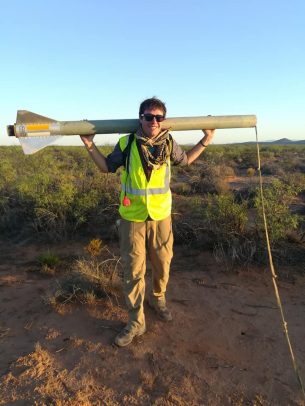Engineering students blast to first place at international competition
The UIC chapter of the American Institute of Aeronautics and Astronautics (AIAA) recently won first place in the “30K Solid Rocket-Student Research and Developed Components” category during the second annual Spaceport America CUP at the Las Cruces Convention Center in New Mexico.
The team competed with its first student-built motor as they successfully flew it and recovered it. This is the first time UIC has won first place at IREC. The team also captured a third-place win with its commercial rocket. Both rockets were flown to approximately 30,000 feet as they topped the competition, including Purdue, Stanford and the University of Minnesota.
The Spaceport America Cup is a partnership between the Experimental Sounding Rocket Association (ESRA) and the New Mexico Spaceport Authority to host and support a week-long series of events, which sets the background and provides structure for the world’s largest university rocket engineering competition. This event continues the Intercollegiate Rocket Engineering Competition’s (IREC) legacy of inspiring student design teams from across the country and around the world. The competition brought together about 1,5000 university students from 10 countries as they competed in six categories that included launching and recovering rockets at the spaceport. Apart from flying the rocket to a set height, the teams were judged based on a technical report and progress reports.
“You also have to recover the rocket and show it to the judges to make sure it’s re-flyable,” said Patrick Begalowski, a student in mechanical and industrial engineering.
“Both of our rockets are immediately re-flyable,” added mechanical and industrial engineering student Michal Pekala. “This is the first n-class motor we ever built, which is one of the biggest motors before going to single use [motors].”
According to Pekala, the team was ready for the competition, which kept the team relaxed during the event.
“Our philosophy is to be prepared so it feels like a vacation,” quipped Pekala. “Everything is made to work, and we were not drilling anything or Dremeling anything or soldering anything major. We did some of it, but it was all minor details.”
While the team was relaxed and confident, the competition wasn’t a holiday in the sun as the UIC team nearly got eliminated based on a communication issue.
“We ended up getting lost and almost got disqualified,” said Pekala. “Our rocket flew four miles and we lost (communication) range after three miles. We were reporting every 15 minutes. I was transmitting, but they weren’t receiving it.”
During the competition, Begalowski and Pekala represented UIC. They were one of only 25 teams accepted to participate in a podium session, where they presented the rocket they are working on with mechanical and industrial engineering assistant professor Patrick Lynch in his laboratory at UIC.
Other UIC team members who attended the competition included mechanical and industrial engineering students Matthew Valenzeno, Rachel Cruz, James Huffaker, and Marcin Maksimowicz, and computer science students Thomas Hein and Corey Habel.
The AIAA chapter at UIC is a student run organization dedicated to the study of aerospace and propulsion engineering. The club was formed in 2011 to provide an outlet for students interested aerospace engineering. Apart from high-powered rockets, the students also design and build remote controlled aircraft and quad-copters.

